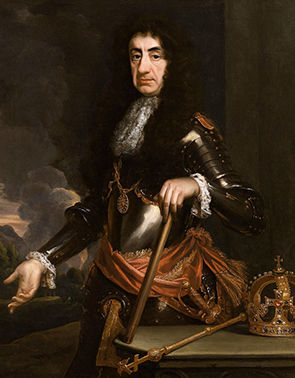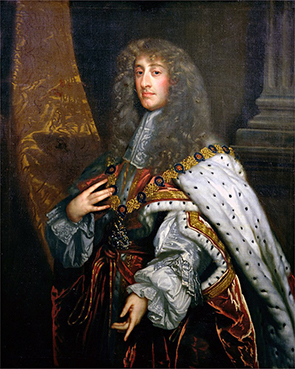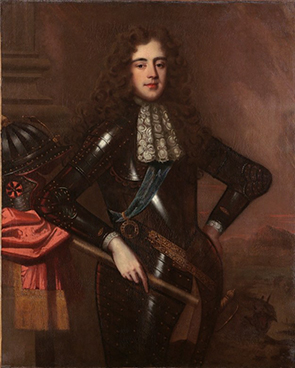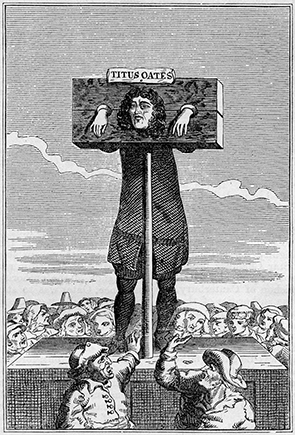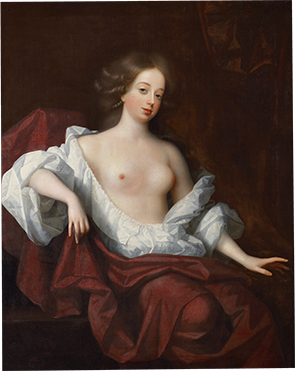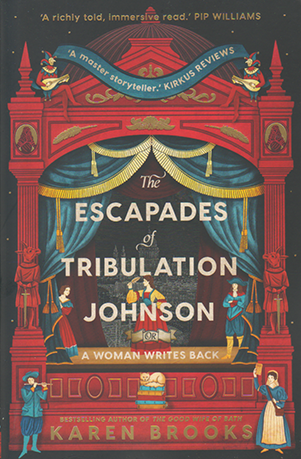
ISBN:9781867227229

- Category:Australian Fiction, Historical Fiction, Feminist Fiction
- Date Read:23 March 2024
- Year Published:2023
- Pages:512

The Escapades of Tribulation Johnson, like Karen Brooks’ previous novel, The Good Wife of Bath, is a historical novel which foregrounds women in history. In The Good Wife of Bath, Brooks imagined the ‘real’ story behind Chaucer’s Alyson arising from Chaucer’s association with Eleanor, the purported inspiration for his character, the Wife of Bath. In twisting the story like this, Brooks was able to give a modern feminist spin to the tale. In this latest novel, Brooks takes the known details of Aphra Behn, the first woman to have supported herself by writing for the theatre, as the basis of a feminist retelling of the period. Aphra lives in Restoration London and the novel is set in a ten year period between 1679 to 1689. While this is the story of, Aphra, it is also the story of Tribulation, who is sent to London by her father to stay with her cousin. Tribulation quickly comes to suspect that her father knows little about Aphra, since Aphra is involved in the theatre and is a well-known writer. During this period in England, theatrical associations could damage a woman’s reputation permanently, given that the theatre was considered little better than prostitution.
Tribulation Johnson reads like intelligent popular fiction, and its historical basis is a fascinating part of English history. The plot around the main characters has a familiar feel to it. Tribulation Johnson is a female version of a typical young male hero, making his way in the world and overcoming adversity. Like Tom Jones, Tribulation’s origins are somewhat muddled and she is raised by a kindly surrogate who helps her find her way. Tribulation’s story is not ground-breaking. In fact, some would deem it somewhat clichéd and commonplace, given its traditional romantic leanings and denouement, which sit alongside its feminist intentions. What I’m suggesting is that Tribulation Johnson is an easy read, partly because Brooks employs a modern vernacular (apart from some words like “cupshodden”, a wonderful term meaning ‘drunk’) and familiar romantic tropes. The question is, is this what a modern audience wants from a novel? Must historical characters who may feel as we do about the situation of women necessarily need to give voice to modern sensibilities?
Given the personal story of Tribulation and her historical context, the nature of change and how it is effected is core to the story. There is the nature of political change, which can be instigated through violence, and there is personal change, as desired by women. As modern readers, we might conceive that feminism addresses systemic issues of inequality that range far beyond individual personal experiences. But as seventeenth century women, Tribulation and Aphra are more conservative than that, and they offer less than what a modern audience may desire. I found the ending somewhat sentimental. Is this a problem?
First, the historical background: the novel is set during a significant period of English history, told primarily from the perspective of Tribulation. By 1679 when this story begins, the character of English drama was changed. At the beginning of the century, when Shakespeare was still alive and writing plays, women were not allowed on stage. Everyone knows that all parts were played by men and boys. If you’re a little fuzzy about the history between Shakespeare and the changes that led to the London of the latter part of the century, then it’s helpful to know that the English Civil War had been fought, Charles I had been defeated, tried and beheaded, and England had had over ten years without a king – a period known as the Interregnum (1649 – 1660). Under Oliver Cromwell, a Puritan at the head of the republican government, theatres remained shut, having been closed at the beginning of the Civil War in 1642. They were, after all, considered breeding pits for sin and likely places to encourage dissension. Effectively, a whole generation of talent had languished in those years, which helps explain some of the popularity of Shakespeare. Older, proven plays were valuable commodities to the reinstated theatres.
But with Cromwell’s death in 1658 and the reinstatement of the monarchy in 1660 under Charles II – the Restoration – theatres had been allowed to re-open, and what is more, women were allowed, for the first time, to take part in productions. Women were not only acting on stage but were involved in management of theatres and even writing. Lady Mary Davenant, who appears as a minor character in this novel, managed the Duke’s Company at Dorset Garden Theatre where Aphra and Tribulation work. Brooks has drawn her from real history just as she has Aphra.
Samuel Pepys, the famous English diarist, records that he saw his first production with a woman onstage as early as January 3 1660. Charles wasn’t even officially king, yet. He became king in May 1660 and his coronation wasn’t until April the following year. It seems Charles, who had lived in exile in France and had seen French theatre with women on stage, appreciated the innovation. So did Samuel Pepys. On the 28 October 1661 he wrote:
Hither I sent for Captain Ferrers to me, who comes with a friend of his, and they and I to the Theatre, and there saw “Argalus and Parthenia,” where a woman acted Parthenia, and came afterwards on the stage in men’s clothes, and had the best legs that ever I saw, and I was very well pleased with it.
The lives of Aphra and Tribulation are woven into the historical events of the period. Things are not going smoothly in Restoration England. A dominant issue during this period is the Popish plot, a falsely reported conspiracy fanned by a man called Titus Oates, who may have been a pawn for men like Anthony Ashley Cooper, Earl of Shaftsbury, who wished to exclude the King’s brother James, Duke of York, from the royal lineage. The Duke was Catholic. A bill was introduced into parliament in May 1679 – the Exclusion Bill – to try to achieve this. Shaftsbury and his followers preferred the King’s son, James, Duke of Monmouth, as Charles’ royal heir. In 1683 the King, himself, was the target of an assassination plot for his pro-Catholic sympathies.
John Dryden, who is a minor personage in this story (at least Samuel Pepys is given a talking part), satirised the conspiracy in his 1681 poem, ‘Absalom and Achitophel’. Written as a Biblical allegory based on Absalom’s rebellion against King David, Dryden portrayed Shaftsbury as the disloyal Ahithophel who turned the King’s son against him. Achitophel’s pitch to Absalom is that basically there is a justification in the use of violence to effect a desired end:
- Succession, for the general good designed,
- In its own wrong a nation cannot bind;
- If altering that the people can relieve,
- Better one suffer than a nation grieve.
Absalom is encouraged to gain favour with the king and appear to act in defence of the crown:
- Prevail yourself of what occasion gives,
- But try your title while your father lives;
- And that your arms may have a fair pretence,
- Proclaim you take them in the King’s defence,
- Whose sacred life each minute would expose
- To plots from seeming friends and secret foes.
This is the essence of the Popish plot as outlined by Brooks; that Catholics would be implicated in a plot against the king to discredit the king’s brother and promote his son, instead. In Tribulation Johnson, Brooks explains it in her typically accessible way:
. . . a former priest named Titus Oates had told the King and privy council about a dreadful plan, concocted by Jesuits in league with many powerful English Catholic nobles, to assassinate his majesty and place his brother, the Romish Duke of York, on the throne in his stead. (20)
Or to put it more explicitly, in the words of spymaster Sir Joseph Williamson (another real historical personage):
. . . while everyone is looking out for vengeful, hateful Catholics, no-one is watching anyone else. It’s the perfect façade. Invent a dreadful far-reaching plot; accuse; make arrests; and, in the meantime, the real plot and plotters go undiscovered. It has Shaftsbury and his sycophants at the Green Ribbon Club written all over it. (48)
This is the historical background of Brooks’ Tribulation Johnson. If you’re unfamiliar with the history and the detail seems potentially overwhelming, I can say that the novel tells you as much as you need to know, and wears the history rather lightly. It helps that Brooks introduces these historical personages as characters in her story. We have direct access to them through the eyes of our protagonist. So it is little effort to feel the contempt Tribulation feels, for instance, when Shaftsbury brazenly inspects her like property:
Unbeknownst to the Earl, I considered him too, taking in his thin cheeks, long, bent nose and the crooked back not even his flowing golden periwig or heavy brocaded jacket could hide. The liberal scent he wore couldn’t quite disguise a strange odour, cloying, sweet and not at all pleasant.
Unattractive characters who receive this kind of description, however unfairly, are almost always bad. So Brooks has provided us with a moral shorthand to introduce a complex historical personage, even if it seems somewhat clichéd. To be fair, though, John Dryden, describing the earl in his 1681 poem, ‘Absalom and Achitophel’, uses the same ploy to discredit him:
- A fiery soul, which working out its way,
- Fretted the pigmy-body to decay,
- And o’er-informed the tenement of clay.
Shaftsbury is sickly and of poor physique. When Brooks first introduces him, Mrs Betterton, an actress, observes, “There was a grandly dressed crook-back who, using a cane, forced people aside.” Brooks immediately associates Shaftsbury’s physical decay with his moral turpitude, as he has scant regard for others about him.
The same can be said for all aspects of the historical setting and its characters. Brooks uses licence where there are gaps and elisions in the historical record, but it is done in the service of delivering a more accessible account to the reader. Aphra, herself, is a good example. Aphra was a real playwright while Tribulation is a fictional character. But Brooks explains in her Author’s Note that she was inspired to invent Tribulation based on an anonymous biography of Aphra Behn penned by ‘One of the Fair Sex’. It’s a sobriquet adopted by Tribulation in the novel as she begins to write pamphlets and plays. The historical author of the biography had an intimate knowledge of Aphra, and she may well have been a close friend, or it may have even been written by Aphra, herself. By inventing Tribulation, Brooks gives herself greater scope to explore the strictures placed on women of the time, the limited scope for advancement, and the limited professional and social respect afforded women, without stepping outside the known facts about Aphra Behn. In essence, Tribulation becomes the mouthpiece of the novel: Aphra’s mouthpiece. Tribulation desires a degree of autonomy she perceives in Aphra:
I’d always felt there had to be more to life than simply listening. For that’s what women did. From the moment we entered the world, we were compelled to keep our lips sealed and ears primed so our fathers, brothers, other men, God, could pour their wisdom into them.
Aphra’s story is about the price paid for independence and a voice. She tells Tribulation, “We cannot win in this game of flesh and desire. No matter how we play it, we always lose.” Aphra’s struggle for independence and respect is paralleled by Tribulation’s own struggles: to deal with her emerging feelings for Gabriel Freeman, a man sent to spy on the theatre to look for popish plots, and her own desire to follow in Aphra’s footsteps and become a writer, herself. Words are the only means by which Tribulation can effect positive change. She achieves it when she writes her first pamphlet, an open letter to the king asking for the theatre to be reopen, as well as reaching the conscience of a rebel. Words are Aphra’s power, Tribulation reflects: “They were my weapons too. My power.” In fact, words take on a physicality: “I used my words, my voice as a sword and was pleased to see every dark utterance, every thrust and parry, was not only heard but felt.”
Tribulation’s presence in the narrative allows a more natural representation of Aphra Behn. Self-praise is always awkward, but through Tribulation’s eyes Aphra’s achievements can be sung, and the revelations about her past are more logically withheld until Tribulation makes discoveries. Tribulation knows Aphra is a writer and was even a spy for England when she was younger, but there is much that remains long hidden, tying the two women together closer than Tribulation realises: why was Aphra sent to prison for debt and who was her former lover?
So, there are two main concerns upon which this novel rests its narrative. The first, naturally, is the treatment of women and their place in society. The second concerns itself with the notion of change. This is tied to the story of the Popish Plot and the plot against the king’s life. And it is tied to the idea of how women’s lives can be made better.
This is where the novel may seem a little anachronistic or conservative to some readers. Tribulation may imagine her words to be swords but she is not militant. Politically, the characters come out on the side on monarchy, for a start. But this is the reality of the historical moment. The choice is monarchy or another civil war. But alongside this is the question of the treatment of women. The novel gives plenty of examples – everything from bum pinching to the repression of women’s voices and violence – to characterise the plight of women in the seventeenth century. But its characters do not see systemic change as a critical step to effect a better situation for women. Tribulation may rail against the paltry amount paid to female authors in comparison to their male counterparts, or the characterisation of women who speak their mind or don’t adopt traditional female submissiveness, but her focus remains fundamentally a personal issue, even if she understands it is an issue she shares with all women. Systemic change in the cause of feminist ideals is modern thinking.
In the political sphere, on the other hand, William Scott, a conspirator who was raised the son of a traitor, advocates violent overthrow: “Sometimes, Tribulation,” he says, “the only way to instigate change is by burning down the old order so a new one might rise.” Scott advocates the killing of the King to effect change. But this does not necessarily correlate to an equally violent overthrow of patriarchal power to effect emancipation for women. Brooks, in her Author’s Note, quotes historian Ian Mortimer on the prevalence of sexism in England during this time to describe the problem: “This is the amazing thing about sexism in Restoration Britain: the prejudices against females are so deep-seated that many women share them.”
Whatever agency is attained by Tribulation through her emulation of Aphra, it remains predominantly through the use of words: in her ability to express a different reality on stage or through her pamphlets. Power for women is predominantly imagined as autonomy and speech, and is not couched in terms of a changed political system or by eschewing men. In The Good Wife of Bath Eleanor expresses a desire to Chaucer that she should be able to marry whomsoever she would. Eventually, she decides,
I wanted authority, aye, but not over my husbands. That made me no better than them. What I really wanted, what I’d learned through experience, was authority over myself. I wanted respect.
In Tribulation Johnson, Tribulation has grown up in a house of secrets. She has suffered the power of men to create her reality. But what Brooks offers is not a radical change, as the novel’s revolutionary themes might suggest, but an evolution which achieves respectful relationships and openness. This is a large part of the point about Tribulation’s growing relationship with Daniel. In modern times a common theme in many revisionist fairy tales is that a female protagonist can break free of the patriarchal narrative: the narrative that Prince Charming is both desirable and needed. But in acknowledging Aphra Behn’s unabashed desire for men, and Tribulation’s relationship with Daniel, Brooks is advocating a position she has already promoted in her previous novel: of equality and respect in relationships. Tribulation states:
I was happy to humour her [Aphra], let her believe I’d no need of a man, but we both knew my heart was with Gabriel and always would be. As Aphra once said, I didn’t need him, I wanted him.
It’s a position that results in a more traditional denouement than many other writers who address feminist issues of equality and independence may have written: more conservative or more centrist, depending on your point of view. But it’s a position that makes sense, historically, as well as morally; I mean the nature of change.
I enjoyed reading Tribulation Johnson, although I didn’t feel it to be as compelling as The Good Wife of Bath. Eleanor is a more mature, more strident character, whose actual self, as defined by her voice in the novel’s narrative, and her fictional self, as appropriated by Chaucer, is a more successful trope to express the feminist ideals of that novel. Like Eleanor, Tribulation is defined by patriarchal paradigms and struggles to find her own voice. But her achievement seems more limited, which is defined through her personal desire is to emulate Aphra, leaving her to step past the failures of her mentor in her own personal life. Whatever you think of this, this is still a fascinating historical novel which will open up the period to a reader unfamiliar with it.

Three Portraits of Aphra Behn
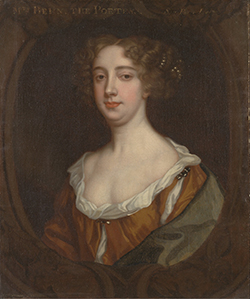
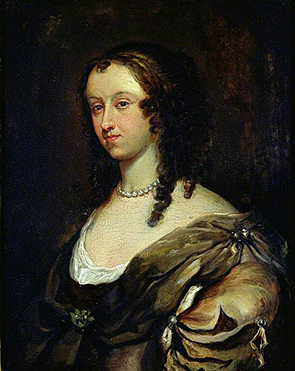
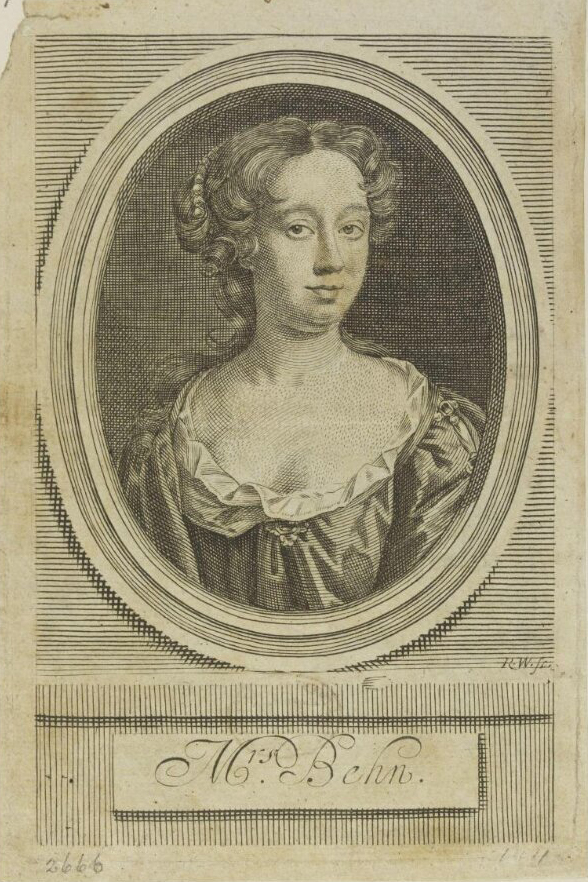
The artist, Mr Robert White, while a very nice man whom I sure did excellent work, failed, in my mind, to capture her. In all fairness, neither of the two portraits I’d seen of Aphra did. They were … unadventurous. Aphra maintained a painter was limited in what they could convey with colour and brushes: that the representation would always be shallow. Turns out, it was the same with an engraver. A writer, on the other hand, could give depth and dimension with a mere word, a phrase or description. When I looked at Mr White’s efforts, I saw a woman like so many others. Pretty, younger than she actually was, with an inoffensive turn of the head and demure brow. Where was my clever, kind cousin who could animate a corpse with her wit?
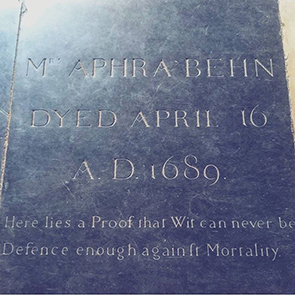
“‘Here lies Proof that Wit can never be Defence enough against Mortality.’”
It still stung these harsh words marked her resting place. Words I hoped my tribute to Aphra as well as her own work would disprove over and over.
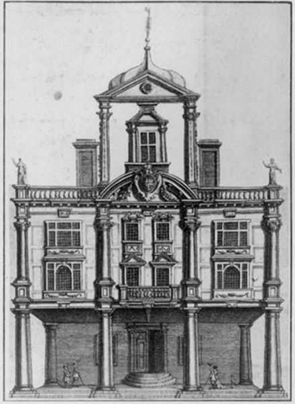
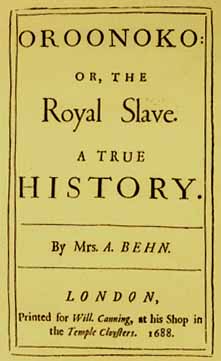
Two works of prose were finished, and on top of that the three volumes of the Love Letters. She also finally wrote the story she’d long wished to tell, of a slave she knew back in Surinam, the noble and tragic Oronooko and his wife, Imoinda.
